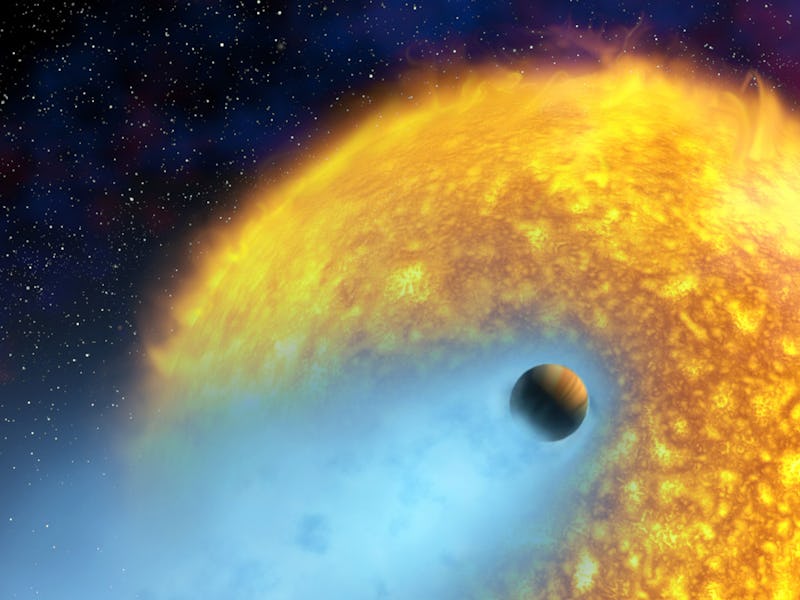Stars may zap the life off their planets — study
Scientists have measured how much stellar flares affect a planet's habitability.

The first exoplanet was discovered more than 20 years ago, and scientists are on the hunt for more of these strange worlds. For many, the quest is driven by one thing: The search for signs of life.
But when looking at whether an exoplanet has the key ingredients for habitability, scientists tend to ignore one crucial factor — the activity of the planet's host star.
A new study suggests they need to start taking it seriously, however. In the paper, the astronomers describe how emissions coming from the host stars can cause a planet to lose its atmosphere. And with no atmosphere, so the theory goes, there can be no life.
The findings are detailed in a study published Sunday in in the journal Monthly Notices of Royal Astronomical Society: Letters.
To understand how planets and stars interact with one another, consider the Earth and the Sun.
One of the main reasons why the Earth is habitable has to do with its distance from the Sun. Our planet is far away enough from its host star that it is protected from the Sun's harmful radiation, yet not so far that it can't be kept warm from the heat of the star. At the same time, it is cool enough to sustain liquid water at the surface.
This delicate balance of neither too hot nor too cold gives this special region its other monicker: The ‘Goldilocks zone.’ Scientists currently know of more than 4,000 exoplanets orbiting around distant stars, and yet none seem to have the right combination of factors to support life in the same way as Earth.
When looking for signs of habitability on other planets, scientists look for water, organic material, a source of energy, and an atmosphere.
A planet’s atmosphere needs to be thick enough to transfer heat and offer insulation. Back in 2019, Inverse spoke to astronomer Billy Quarles about this exact problem on Earth: Basically, if the Earth didn’t have its atmosphere, for example, the temperature at the surface would reach as low as -20 degrees Celsius.
The artist's conception shows a hypothetical planet with two moons orbiting in the habitable zone of a red dwarf star.
But the new study suggests that the nature of a planet's atmosphere is, at least in part, dependent on its host star. And that affects whether the planet has the ability to sustain water on its surface.
"Given the close proximity of exoplanets to host stars, it is vital to understand how space weather events tied to those stars can affect the habitability of the exoplanet," Dimitra Atri, a research scientist at the Center for Space Science at NYU Abu Dhabi and co-author on the new paper, said in a statement accompanying the research.
For the study, the scientists looked at the stellar flares, or emissions of radiation, from different type of stars. These emissions contain extreme ultraviolet photons and charged particles that can alter the upper atmosphere of its orbiting exoplanet.
They discovered that the more frequent, lower energy stellar flares had a greater impact on the exoplanet's atmosphere than the less frequent, higher energy flares.
The study changes how scientists look for potentially habitable corners of the cosmos, suggesting that they need to take into consideration a star's radiation when calculating exoplanets' ability to host life.
"The next research step would be to expand our data set to analyze stellar flares from a larger variety of stars to see the long-term effects of stellar activity, and to identify more potentially habitable exoplanets," Atri said.
Abstract: Space weather plays an important role in the evolution of planetary atmospheres. Observations have shown that stellar flares emit energy in a wide energy range (10^30-10^38 ergs), a fraction of which lies in X-rays and extreme ultraviolet (XUV). These flares heat the upper atmosphere of a planet, leading to increased escape rates, and can result in atmospheric erosion over a period of time. Observations also suggest that primordial terrestrial planets can accrete voluminous H/He envelopes. Stellar radiation can erode these protoatmospheres over time, and the extent of this erosion has implications for the planet's habitability. We use the energy-limited equation to calculate hydrodynamic escape rates from these protoatmospheres irradiated by XUV stellar flares and luminosity. We use the Flare-Frequency Distribution of 492 FGKM stars observed with TESS to estimate atmospheric loss in Habitable Zone planets. We find that for most stars, luminosity-induced escape is the main loss mechanism, with a minor contribution from flares. However, flares dominate the loss mechanism of ∼20\% M4-M10 stars. M0-M4 stars are most likely to completely erode both their proto- and secondary atmospheres, and M4-M10 are least likely to erode secondary atmospheres. We discuss the implications of these results on planetary habitability.
This article was originally published on